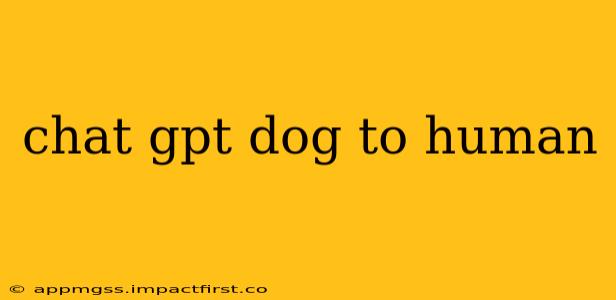Dogs can't literally use ChatGPT, but they're masters of communication in their own right. Understanding their subtle cues is key to a strong human-animal bond. This article dives deep into interpreting your dog's "messages," exploring common canine behaviors and how to best respond. We'll tackle some frequently asked questions to help you become a more fluent "translator" of your dog's unique language.
What are the main ways dogs communicate with humans?
Dogs communicate primarily through a combination of body language, vocalizations, and scent. Their body language – tail wags, ear position, posture – is incredibly informative. A wagging tail isn't always a sign of happiness; the way the tail wags, combined with other cues, tells the whole story. Vocalizations, from happy barks to whines and growls, also convey important information, as does their use of scent marking to leave messages for other dogs (and sometimes, for you!). Understanding the nuances of these communication methods is crucial for fostering a strong bond and preventing misunderstandings.
How can I tell if my dog is happy, sad, or anxious?
Identifying your dog's emotional state involves observing the whole picture. A happy dog might exhibit relaxed posture, playful tail wags, and a loose, open mouth. Sadness, on the other hand, often manifests as lethargy, decreased appetite, changes in sleeping patterns, and a tucked tail. Anxiety can present in many ways – panting, pacing, trembling, hiding, or excessive barking – and requires careful observation and potentially veterinary attention. Remember that dogs communicate subtly; the context of the situation plays a critical role in interpreting their signals.
What does it mean when my dog stares at me?
A staring dog isn't necessarily being aggressive. The context is key. A prolonged stare, especially coupled with stiff posture, might signal anxiety or aggression. However, a soft, brief gaze can be a sign of affection or seeking attention. The subtle differences in intensity and duration of the stare, along with other accompanying body language, will help you decipher its meaning. Consider the overall body language – is the dog relaxed or tense? Is the tail wagging or tucked?
How can I better understand my dog's needs?
Regular observation is vital. Pay close attention to your dog's behavior throughout the day. Note their responses to different stimuli – other dogs, people, noises, situations. This consistent monitoring helps you build a detailed understanding of their preferences, triggers, and communication style. Consider keeping a journal to document observations and track any changes in behavior. A veterinarian or certified professional dog trainer can also offer valuable insights and guidance.
My dog whines a lot, what could this mean?
Whining can signal several things – a need for attention, pain, discomfort, anxiety, or even excitement. To understand the reason behind the whining, pay close attention to the context. Is the whining accompanied by other behaviors? Is your dog looking at a specific object or location? If the whining is persistent or accompanied by other symptoms, a veterinary examination is recommended to rule out any medical issues.
How can I improve communication with my dog?
Improving communication is a two-way street. Focus on clear and consistent commands, positive reinforcement, and building trust. Spend quality time interacting with your dog using positive training methods. Engage in activities they enjoy, providing plenty of opportunities for physical and mental stimulation. Understanding their individual personality and learning their communication cues are essential for building a strong and harmonious relationship. Consider professional training to learn effective communication strategies tailored to your dog's breed and temperament.
By paying close attention to your dog's body language, vocalizations, and overall behavior, you can develop a deeper understanding of their communication style. This understanding fosters a stronger bond and allows you to meet your dog's needs effectively, leading to a happier and healthier life for both of you. Remember, it's an ongoing learning process—the more time you spend observing and interacting with your canine companion, the better you'll become at deciphering their "ChatGPT"—their unique and invaluable way of communicating with you.
